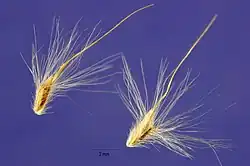Bothriochloa saccharoides
| Bothriochloa saccharoides | |
|---|---|

| |
| Seeds | |
| Scientific classification | |
| Kingdom: | Plantae |
| Clade: | Tracheophytes |
| Clade: | Angiosperms |
| Clade: | Monocots |
| Clade: | Commelinids |
| Order: | Poales |
| Family: | Poaceae |
| Subfamily: | Panicoideae |
| Genus: | Bothriochloa |
| Species: | B. saccharoides
|
| Binomial name | |
| Bothriochloa saccharoides | |
Bothriochloa saccharoides is a species of grass known by the common name silver bluestem.[2][3] It is native to the Americas, including Mexico, the Caribbean, and parts of Central and South America.[4]
This perennial bunchgrass grows to 2 to 3 feet in height. The leaves reach 8 inches long. The stems are often purplish toward the base. The inflorescence is white and hairy. The plant produces many seeds.[3]
This species is used for grazing cattle, especially in the spring before the inflorescences form. Goats eat the seed heads. The grass can be added to a hay mix.[2]
References
- ^ NatureServe: Bothriochloa saccharoides
- ^ a b USDA Plants Profile for Bothriochloa saccharoides
- ^ a b Bothriochloa saccharoides. USDA NRCS Plant Fact Sheet.
- ^ "Bothriochloa saccharoides". Germplasm Resources Information Network. Agricultural Research Service, United States Department of Agriculture. Retrieved 23 January 2018.
